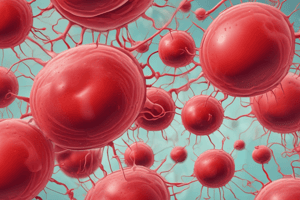Podcast
Questions and Answers
Which blood component is primarily responsible for transporting oxygen from the lungs to the tissues?
Which blood component is primarily responsible for transporting oxygen from the lungs to the tissues?
- Plasma
- Erythrocytes (correct)
- Platelets
- Leukocytes
What is one of the key roles of neutrophils in the immune system?
What is one of the key roles of neutrophils in the immune system?
- Produce antibodies
- Release histamine
- Phagocytize bacteria and fungi (correct)
- Differentiate into macrophages
How do platelets primarily contribute to hemostasis?
How do platelets primarily contribute to hemostasis?
- By clumping together at the site of injury (correct)
- By regulating body temperature
- By transporting nutrients
- By producing antibodies
What is the primary function of hemoglobin in erythrocytes?
What is the primary function of hemoglobin in erythrocytes?
Which type of leukocyte is involved in the humoral immune response by producing antibodies?
Which type of leukocyte is involved in the humoral immune response by producing antibodies?
What condition results from a low platelet count, increasing the risk of bleeding?
What condition results from a low platelet count, increasing the risk of bleeding?
Which leucocyte type is primarily responsible for combating parasitic infections?
Which leucocyte type is primarily responsible for combating parasitic infections?
What is the primary mechanism by which erythrocytes maintain blood pH balance?
What is the primary mechanism by which erythrocytes maintain blood pH balance?
Study Notes
Functions of Blood
- Transportation:
- Oxygen from lungs to tissues
- Carbon dioxide from tissues to lungs
- Nutrients from digestive tract to cells
- Hormones from glands to target organs
- Regulation:
- Maintains body temperature through heat distribution
- Regulates pH and electrolyte balance
- Controls fluid balance in tissues
- Protection:
- Immune defense against pathogens (via leukocytes)
- Clotting mechanisms to prevent blood loss from injury
Erythrocyte Structure and Function
- Structure:
- Biconcave disc shape increases surface area for gas exchange
- Lacks nucleus and organelles to maximize space for hemoglobin
- Contains hemoglobin, a protein that binds oxygen and carbon dioxide
- Function:
- Oxygen transport: Hemoglobin binds oxygen in lungs and releases it in tissues
- Carbon dioxide transport: Carries CO2 from tissues back to lungs for exhalation
- Buffering: Aids in maintaining blood pH
Leucocyte Types and Roles
- Types of Leucocytes:
- Neutrophils: First responders to infection; phagocytize bacteria and fungi.
- Lymphocytes:
- B cells: Produce antibodies; involved in humoral immunity.
- T cells: Helper T cells coordinate immune response; cytotoxic T cells kill infected cells.
- Monocytes: Differentiate into macrophages; phagocytize pathogens and debris.
- Eosinophils: Combat parasitic infections and mediate allergic responses.
- Basophils: Release histamine during allergic reactions and inflammation.
- Roles:
- Immune defense against infections
- Removal of dead and damaged tissues
- Regulation of immune responses
Platelet Function and Disorders
- Function:
- Primary role in hemostasis: sealing damaged blood vessels to prevent bleeding.
- Aggregation: Platelets clump together at the site of a vessel injury.
- Release of chemical signals (e.g., ADP, thromboxane) to attract more platelets and initiate coagulation cascade.
- Disorders:
- Thrombocytopenia: Low platelet count, leading to increased risk of bleeding.
- Thrombocytopathy: Dysfunctional platelets, causing improper clotting despite normal counts.
- Thrombosis: Excessive platelet activation can lead to inappropriate blood clot formation, which can cause vascular blockages.
Blood Functions
- Transports oxygen from lungs to tissues and carbon dioxide from tissues to lungs.
- Delivers nutrients from the digestive tract to cells and hormones from glands to target organs.
- Regulates body temperature through heat distribution, controls fluid balance in tissues, and maintains pH and electrolyte balance.
- Protects the body through immune defense against pathogens via leukocytes and clotting mechanisms to prevent blood loss from injuries.
Erythrocyte Structure and Function
- Biconcave disc shape maximizes surface area for gas exchange.
- Lacks nucleus and organelles to maximize space for hemoglobin, a protein that binds oxygen and carbon dioxide.
- Hemoglobin binds oxygen in lungs and releases it in tissues.
- Erythrocytes carry carbon dioxide from tissues back to the lungs for exhalation.
- Aid in maintaining blood pH.
Leucocyte Types and Roles
- Neutrophils are first responders to infection, phagocytizing bacteria and fungi.
- Lymphocytes are involved in immune responses:
- B cells produce antibodies and participate in humoral immunity.
- T cells coordinate immune response, with helper T cells and cytotoxic T cells that kill infected cells.
- Monocytes differentiate into macrophages, phagocytizing pathogens and debris.
- Eosinophils combat parasitic infections and mediate allergic responses.
- Basophils release histamine during allergic reactions and inflammation.
- Leucocytes play essential roles in immune defense, removing dead and damaged tissues, and regulating immune responses.
Platelet Function and Disorders
- Platelets are crucial for hemostasis, sealing damaged blood vessels to prevent bleeding.
- They aggregate at the site of vessel injury.
- Platelets release chemical signals like ADP and thromboxane, attracting more platelets and initiating the coagulation cascade.
- Thrombocytopenia is a low platelet count, increasing the risk of bleeding.
- Thrombocytopathy involves dysfunctional platelets, causing improper clotting even with normal platelet counts.
- Thrombosis results from excessive platelet activation, leading to inappropriate blood clot formation, which can cause vascular blockages.
Studying That Suits You
Use AI to generate personalized quizzes and flashcards to suit your learning preferences.
Description
Explore the essential functions of blood, including transportation, regulation, and protection. Understand the structure and function of erythrocytes in gas exchange and pH maintenance. This quiz will test your knowledge on these vital topics in human biology.




